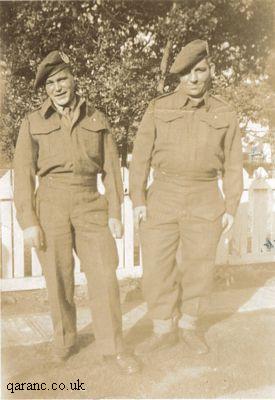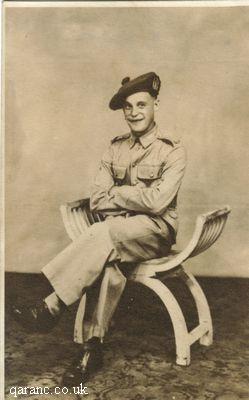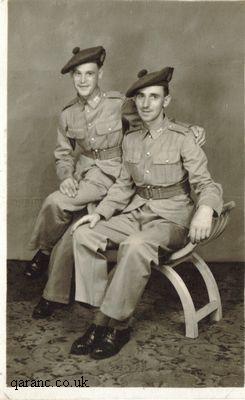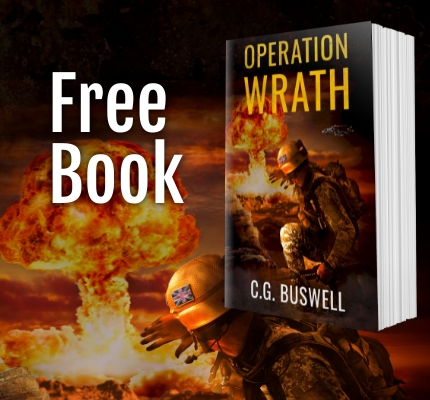Gordon Highlanders WW2
Photographs and history of George Main who served with the Gordon Highlanders in World War Two in Malaya and was a Prisoner of War of the Japanese:
This page is dedicated to George Main who served with the Gordon Highlanders in WW2 and was the grandfather of the author of qaranc.co.uk
The Gordon Highlander soldier on the left in the photo below is George Main. He was born on the 12 April 1915.

George Main
The service number for Private George Main was 2885767. He enlisted at Aberdeen on the 18 April 1940 to the 2nd Battalion Gordon Highlanders. During World War Two he served in Malaya from the 5 August 1940 before becoming a Prisoner of War Far East, being listed as missing on the 15 February 1942, listed as Y List POW on December 1945 and discharged medically unfit for further service due to his Prisoner of War experiences at the hands of the Japanese for 1290 days, being released on the 1 December 1945.
Read more about the Gordon Highlanders Far East Prisoners of War in The Forgotten Highlander: My Incredible Story of Survival During the War in the Far East
Prisoner of War Camp
The photo below was taken at a WW2 Japanese Prisoner of War Camp in October 1944 at Hakodate POW Camp, Hokaido, Japan. The back of the photograph has Japanese lettering. Private George Main is fourth from the left on the front row.

Paul Carter, whose father was a POW there, has published Survival of the Fittest: A Young Englishman's Struggle as a Prisoner of War in Java and Japan
More photos and information about Hakodate POW camp can be found at www.cofepow.org.uk which includes thoughts that the photos were taken for propaganda reasons perhaps prior to a Red Cross visit.
Scattered Under The Rising Sun
Scattered Under the Rising Sun: The Gordon Highlanders in the Far East 1941-1945
Scattered Under the Rising Sun: The Gordon Highlanders in the Far East 1941-1945 covers the move to the new Selarang Barracks in the Changi area of Singapore Island in 1937 and describes the idyll social life, sports and military exercises and training of the Gordonís. With the imminent war looming new conscription rules were passed in the National Service (Armed Forces) Act 1939 which would have affected George Main and his friend Alexander (Sonny) Stewart from Aberdeen who were conscripted in 1940. The first conscripted men of the Gordon Highlanders during the Second World War were posted to the 2nd Battalion at Selarang Barracks in Singapore. They were mobilised by train from Aberdeen to Liverpool then sailed on MV Batory in August 1940 arriving on 15 November 1941.
When the threat of an invasion by the Japanese grew the 2nd Battalion Gordon Highlanders moved on the 1 December 1941 to Pengerang, across the Straits of Johore, to guard artillery installations and strengthen the defences. The families were evacuation home to Britain on the 20 January 1942 aboard the Duchess of Bedford amid an air raid. They arrived safely at Liverpool Port on the 2 April 1942. The men remained as part of the Singapore Garrison Force.
Then on 21 January 1942 the Battalion left Pengerang to join the defence of Malaya and their first battle was on 26 January 1942 at 41 Milestone on the Ayer Hitam Road. This battle, with the wounded and those killed, is described in Scattered Under the Rising Sun: The Gordon Highlanders in the Far East 1941-1945. As the strategic withdrawal of British and Allied troops continued the Gordon Highlanders and the Argyll and Southern Highlanders remained in mainland Malaya. They were piped across the Causeway and this was then blown up to try and prevent the Japanese army advance. The 2nd Battalion Gordon Highlanders then moved to Birdwood Camp in Singapore then to Tyersall Park on the 11 February 1942. The next day they encountered heavier fighting at Bukit Timahwhich included being attacked by Japanese tanks. This battle is also narrated in Scattered Under the Rising Sun: The Gordon Highlanders in the Far East 1941-1945 including those brave Highlanders killed in action.
The British surrendered at 8:30pm on the 15 February 1942. The Gordon Highlanders were marched 14 miles to a Prisoner of War camp in the Changi area. They were immediately put to work clearing roads and area damaged by air raids and fighting, unloading cargo from ships and even clearing mine which resulted in several casualties and deaths. Other Gordon Highlanders were transferred to camps at Havelock Road, Adams Road, Sine Road and Normanton. From here the Gordon Highlander POWís were moved, often by forced march or packed in train wagons or in the holds of hell ships, throughout South East Asia and used as forced labour. This included working in copper mines, building airfields and building the infamous Burma railway. The soldiers received little food and conditions were dire. This is described in much more detail in Scattered Under the Rising Sun: The Gordon Highlanders in the Far East 1941-1945
Like many Gordon Highlanders WW2 FEPOW soldiers George Main told his family little of his time at the hands of the soldiers of Japan. He did tell his daughter that he was lucky to be alive because they were coarse and ill treated the British soldiers at every opportunity. He was close to death once after a Japanese soldier threw a pick axe at his back and he received terrible injuries. He recalled this leading to a near death experience and seeing his mother. His wounds took a long time to heal in the harsh conditions of the prison camp with little medical care, drug and dressings.

After his release from the WW2 POW camp he was taken to BMH Singapore for nursing care and medical treatment where his wounds and malnourished state were treated. He was then taken to special military camps in America and Canada to recuperate. Many thought at the time that FEPOW's were not returned to the UK quickly because their skeletal appearance would have been bad propaganda. The reality was that they needed to recover physically and emotionally from their cruel treatments in the camps. Many would not have survived the long journey home by sea without this valuable recuperation period. To demonstrate just how long this took Private George Main was not discharged from the army until February 1946 and still suffered health problems from his time as a Far East Prisoner of War.

His soldier's release book class "A" registration was PTH/DIV/V SR 1623.
His release papers were dated 16 Feb 1946 at Perth and Unit given as Y List POW. His military conduct was described as Exemplary. On his discharge from the army George Main was awarded a 20% war pension for malnutrition and privation with associated postural defects and tropical ulcers. Comparing the photos below of Pte George Main you can see the weight loss caused by being a FEPOW.
As a civilian in post war years George Main became a plastic moulder.
George Main died on the 9 April 1968 at 0530 hours in Eastern General Hospital, Leith. He was aged 52 years. His cause of death was Angiosarcoma of the small intestine and Carcinomatosis which could be argued were caused by his years of abuse at the hands of Japanese troops as a Far Eastern Prisoner of War. He was survived by his wife Margaret Stewart Main and their children Sandy, Helen, George and Carol. They lived at 8 Croft Road, Murray 2, East Kilbride. His father was George Green Main a retired General Dealer and Robina Main (nee Black) who lived at 9 Froghall Place, St Machar in Aberdeen.

The discharge papers of George Main Gordon Highlanders WW2 read:
Territorial Army Record of Service Paper of a man deemed to have been enlisted into the Territorial Army for the duration of the Emergency under the provisions of the National Service (Armed Forces) Act 1939.
Army Number: 2885767
Name: Main George
Regiment: Gordons 015
Nature of Engagement: AC
Service Trade: N/T (Non Technical)
Military Conduct: Exemplary
This man was a POW in Jap hands for over three years. He has given every satisfaction during his service and he is thoroughly honest and sober, reliable and trustworthy. He should do well on taking up civilian life again. 16 Feb 1946 (written by a Captain of the Gordon Highrs)
Private George Main of the Gordon Highlanders was awarded the following WW2 medals:
1939/45 Pacific Star (Burma Star)
Defence Medal
War Medal 1939/45
See also the Gordon Highlander Edward Stanley Barton page.
If you would like to contribute any info or photographs related to Gordon Highlanders WW2 please contact me.
Follow us on Facebook, Instagram and Twitter.

My PTSD assistance dog, Lynne, and I have written a book about how she helps me with my military Post Traumatic Stress Disorder, anxiety, and depression. I talk about my time in the QAs and the coping strategies I now use to be in my best health.
Along the way, I have had help from various military charities, such as Help for Heroes and The Not Forgotten Association and royalties from this book will go to them and other charities like Bravehound, who paired me with my four-legged best friend.
I talk openly about the death of my son by suicide and the help I got from psychotherapy and counselling and grief charities like The Compassionate Friends.
The author, Damien Lewis, said of Lynne:
"A powerful account of what one dog means to one man on his road to recovery. Both heart-warming and life-affirming. Bravo Chris and Lynne. Bravo Bravehound."
Download.
Buy the Paperback.

This beautiful QARANC Poppy Pin Badge is available from the Royal British Legion Poppy Shop.
For those searching military records, for information on a former nurse of the QAIMNS, QARANC, Royal Red Cross, VAD and other nursing organisations or other military Corps and Regiments, please try Genes Reunited where you can search for ancestors from military records, census, birth, marriages and death certificates as well as over 673 million family trees. At GenesReunited it is free to build your family tree online and is one of the quickest and easiest ways to discover your family history and accessing army service records.
More Information.
Another genealogy website which gives you access to military records and allows you to build a family tree is Find My Past which has a free trial.

Former Royal Air Force Regiment Gunner Jason Harper witnesses a foreign jet fly over his Aberdeenshire home. It is spilling a strange yellow smoke. Minutes later, his wife, Pippa, telephones him, shouting that she needs him. They then get cut off. He sets straight out, unprepared for the nightmare that unfolds during his journey. Everyone seems to want to kill him.
Along the way, he pairs up with fellow survivor Imogen. But she enjoys killing the living dead far too much. Will she kill Jason in her blood thirst? Or will she hinder his journey through this zombie filled dystopian landscape to find his pregnant wife?
The Fence is the first in this series of post-apocalyptic military survival thrillers from the torturous mind of former British army nurse, now horror and science fiction novel writer, C.G. Buswell.
Download Now.
Buy the Paperback.
If you would like to contribute to this page, suggest changes or inclusions to this website or would like to send me a photograph then please e-mail me.

Free Book.
The death of the Brotherhood will be avenged.
RAF gunner Jason Harper and a team of Special Air Service operators are enraged after the death of their brothers by a terrorist drone strike. They fly into south-eastern Yemen on a Black-op mission to gather intelligence and avenge the death of their comrades.
Can they infiltrate the Al-Queda insurgents' camp, stay undetected, and call down their own drone missile strike and get home safely?
Will they all survive to fight another day?
Operation Wrath is a free, fast-paced adventure prequel to the non-stop action The Fence series by military veteran author C.G. Buswell.
Download for free on any device and read today.
This website is not affiliated or endorsed by The Queen Alexandra's Royal Army Nursing Corps (QARANC) or the Ministry of Defence.

